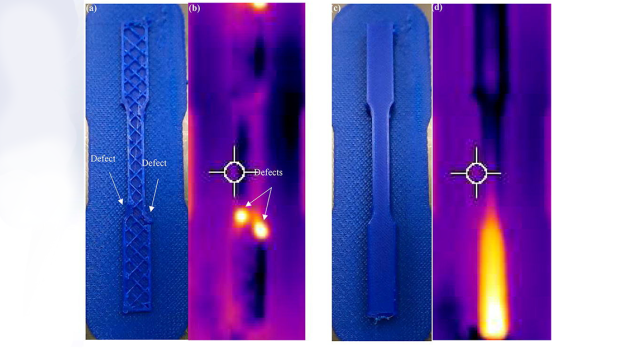Comprehensive study reviews best ways to monitor defects in additive manufacturing

figure from https://doi.org/10.1016/j.matdes.2022.111063
Additive Manufacturing (AM) — commonly known as 3D printing — involves manufacturing processes that depend on a user-defined set of optimized parameters. Monitoring and control of these processes in real-time can help achieve operational stability and repeatability to produce high-quality parts. By applying in-situ monitoring methods to AM procedures, defects in the printed parts can be detected.
In a new review in the Elsevier journal Materials & Design, Nikhil Gupta, professor of mechanical and aerospace engineering and director of the Composite Materials and Mechanics Laboratory at NYU Tandon, and Youssef AbouelNour, a doctoral student under Gupta’s guidance, examine the application of both imaging and acoustic methods for the detection of sub-surface and internal defects.
The imaging methods consist of visual and thermal monitoring techniques, such as optical cameras, infrared (IR) cameras, and X-ray imaging. The data is abundant as numerous studies have been conducted proving the reliability of imaging methods in monitoring the printing process and build area, as well as detecting defects.
Acoustic methods rely on acoustic sensing technologies and signal processing methods to acquire and analyze acoustic signals, respectively. Raw acoustic emission signals can correlate to particular defect mechanisms using methods of feature extraction. In their review, Gupta and AbouelNour discuss processing, representation and analysis of the acquired in-situ data from both imaging and acoustic methods. They also introduce ex-situ testing techniques as methods for verification of results gained from in-situ monitoring data.
Among their revelations:
- In-situ process monitoring methods can create a closed-loop AM process capable of defect correction and control, to ensure process stability and repeatability
- Integration of monitoring methods and machine learning in the AM process can help in continuously evaluating the quality of material deposition and developing intervention methods for correcting the defects in-situ
- And using x-ray Computed Tomography can lead to an in-depth evaluation of defects, as well as an assessment of the quality of in-situ monitoring methods.
- Integration of quality monitoring methods with the manufacturing methods eliminates the requirement to conduct the quality assessment separately, which can save a significant amount of time.
Separately, Gupta this year was honored as a Fellow of ASM International, a global organization of more than 20,000 members. The organization recognized Gupta for “pioneering contributions to the science and technology of lightweight polymer and metal matrix composites” and exceptional dedication to educating the public about scientific discoveries.
The work was supported by the Texas A&M Engineering Experiment Station and the National Science Foundation.





